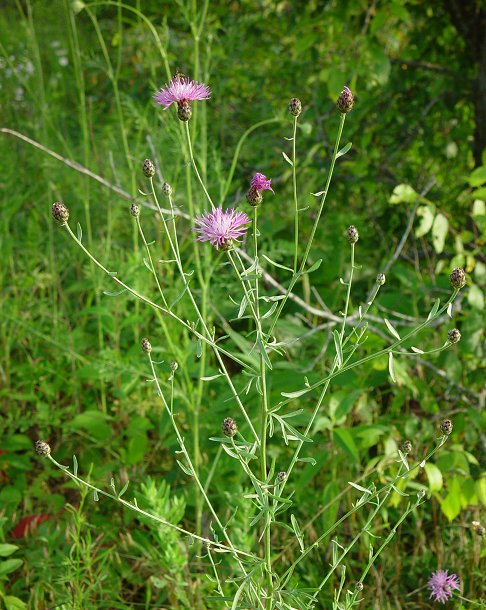Centaurea stoebe L.
Spotted Knapweed

Introduced
CC = *
CW = 5
MOC = 35
© DETenaglia
Centaurea stoebe L.Spotted Knapweed | |
 |
Introduced CC = * CW = 5 MOC = 35 |
© DETenaglia |
|
Family - Asteraceae/Cardueae Habit - Taprooted, short lived perennial. Stems - Ascending to erect, to reclining with age, to 1.5 m, ridged, with ascending branches above the midpoint, pubescent with woolly or cobwebby hairs when young.
Leaves - Alternate, 3-15 cm long, dotted with minute, yellow to brown resin glands; basal and lower stem leaves with the blades mostly 40-70 mm wide, oblanceolate to elliptic, angled to a usually bluntly pointed tip and often also with a minute, sharp point, sessile or short-petiolate, mostly deeply pinnatifid, the lobes lanceolate to elliptic, entire or few-toothed; median and upper stem leaves gradually reduced, mostly sessile, the blades of the main stem leaves with 1 to several pairs of mostly linear lobes, those of the uppermost leaves sometimes unlobed. Leaves in upper portions of stem greatly reduced, mostly undivided, scabrous, typically cobwebby-pubescent, mucronate, linear to oblong.
Inflorescence - Solitary terminal heads. Heads - Involucre 9-13 mm long, narrower than to about as long as wide, ovoid. Lower and median involucral bracts with the body ovate to oblong-ovate, the margins entire, the outer surface glabrous or cobwebby-hairy, not concealed by the appendages, the outer surface with several darker, parallel veins or ribs; the apical appendage more or less well differentiated, ascending, about as wide as the main body, not overlapping, brown to dark brown or black, the involucre with at least some green coloration easily visible, the margins fringed with stiff, spreading or loosely upward-curved, parallel bristles. Upper involucral bracts with the appendages less differentiated, entire to irregularly toothed along the margins, the tips mostly bluntly pointed.
Ray florets - Absent, but with marginal florets sometimes somewhat resembling rays. Disk florets - Whitish to pinkish-purple. Outermost flowers 15-25 mm long, enlarged, sterile, 5-lobed, the lobes enlarged but usually not much expanded laterally. Innermost flowers 12-15 mm long, 5-lobed, fertile. Lobes to 4 mm long. Anthers pinkish-rose, exserted, fused around style, 2-3 mm long. Pappus of short bristles to 2 mm long, rarely absent, white.
Fruits - 2.5-3.5 mm long, somewhat flattened, the attachment scar appearing lateral, the surface grayish brown to brown with lighter stripes, glabrous or finely hairy. Flowering - June - September. Habitat - Waste ground, rocky ground, roadsides, railroads. Origin - Native to Europe. Lookalikes - Potentially, other members of the Centaurea genus; however, these are mostly rare in Missouri. Other info. - This plant is considered a pest across almost the entire western half of the continental U.S., where it infests overgrazed rangelands. In Missouri it is most common in the southern third of the state, widely scattered or absent elsewhere. In most areas of Missouri it is less a problem than in western states. The plant is relatively easy to recognize, at least to genus, but could be confused with other members of the genus which also occur sporadically and uncommonly in the state. Photographs taken at Logan Creek, Reynolds County, MO., 6-20-03 (DETenaglia); also near Mountain Grove, Wright County, MO, 6-30-2011, Tyson County Park, St. Louis County, MO, 8-6-2012, and the Dena Mora rest area along I-90, Mineral County, MT, 8-23-2012 (SRTurner). |